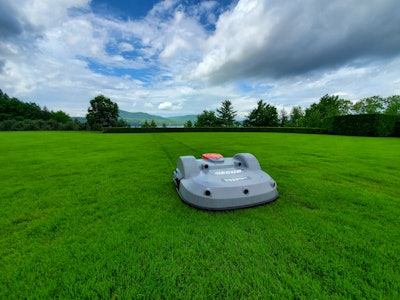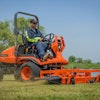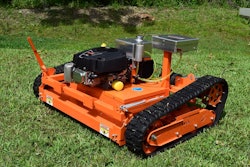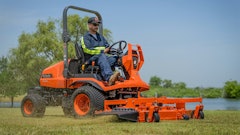
For some, the phrase “the rise of robotics” may call to mind futuristic scenes in which robots have taken over the workforce and humans become irrelevant.
On the contrary, robotic mowing technology has been designed to help the landscaping industry rise up.
“Sometimes we see people against robotics because they think robots are meant to take people's jobs, which is not the case,” says Benjamin Houssa, vice president for robotics at Echo Robotics. “It’s really to give opportunity for businesses to grow. That’s where the industry should be excited and embrace this new technology.”
Several robotic mower experts shed light on how this technology can help landscape companies become more efficient and profitable.
The labor factor
It’s no secret that labor has stood out as a primary concern among landscape professionals for several years, even before the pandemic.
That’s where robotic mower technology can ease the strain, according to Alok Sarna, vice president of business development for URS Robot, developer of NexMow.
“We're not focused on wanting to replace labor; we're focused on labor efficiency and how the labor can be repurposed,” Sarna says.
Todd Zimmerman, vice president of product development for PositecUSA., parent company of Worx, agrees.
“Robotic mowers help save on labor and time spent on the site,” Zimmerman says. “For example, depending on the brand, current technology may allow a mower to be installed in a given area, so when crews are coming back to do their regular maintenance, they’re going through the yard and completing the trimming, edging and blowing.”
In other words, if there’s a robotic mower on-site, the human crews can perform the work that requires a human touch.
“If you do find qualified labor, do you really want them sitting on a mower mindlessly all day or do you want them creating value-added benefits for your clients?” asks Jake Vollbeer, robotics national sales manager for Echo Robotics. “For landscapers looking to separate themselves, automation is a way to be on the forefront of that.”
Perhaps most important is ensuring the safety of the crews landscape companies have on-site.
Robotic technology provides a safer alternative to push and ride-on mowers, especially when mowing on slopes, according to Amber Hatch, administrative assistant at Evatech.
“The biggest benefit is that they can be used in any dangerous area instead of people tying themselves to a tree with a weed whacker to mow the grass there,” Hatch says. “It increases productivity, and the robotic mowers get it done more efficiently, safer and faster.”
Upping efficiency
To implement robotic mowing technology into a fleet, it’s about figuring out how to best leverage technology within the existing systems of the operation, according to Billy Otteman, director of marketing at Scythe Robotics.
“As landscapers figure out how to integrate the robotic mowers into their businesses, they will identify how this equipment can fit into and improve operations, increase productivity, make the job of the crew easier and help multiply what they can do on jobsites,” Otteman says.
Otteman adds that landscape contractors should include an evaluation period after incorporating the mowers to find out where they’re seeing improvements and where friction points can be addressed.
For example, Vollbeer notes that it's important to pick sites that give robotic mowers the best chance for success, such as relatively open areas that aren’t prone to a lot of flooding.
“There’s a lot of planning and looking at landscape contractors’ portfolio of clients and knowing where they can take automation and implement it successfully,” Vollbeer says.
When the technology is implemented correctly, landscape companies can become more efficient in both manpower and the amount of product put down.
“From a plant physiology standpoint, robotic mowers greatly reduce the stress that you're putting on the plant, so you're going to use less fertilizer and the grass is going to be denser through frequent daily mowing,” Vollbeer says. “You're still going to have to do some spraying in application, but you're going to reduce a lot of those inputs.”
Finally, because robotic mowers mostly rely on electric power, landscape companies can increase their fuel efficiency as well.
With rising gas prices and tightening regulations on gas-powered equipment, this shift to electrification is key, Sarna says.
“There’s a move to toward cleaner energy. In California, there's been a rush to clean energy solutions because of the regulations kicking in in 2024,” Sarna says.
Otteman agrees.
“We can use this advanced technology to better take care of the environment by scaling our ability to take care of the planet and take care of our green spaces,” Otteman says. “With landscaping being at the forefront of green space management, we've had a renewed conversation about environmentalism, and that's starting to shape a lot of the conversation within the industry.”
Addressing the challenges
Some landscape contractors may still be skeptical—what about challenges relating to upfront cost, run time and training?
Upfront cost
When it comes to concern over the upfront cost of mowers, Vollbeer encourages landscape companies to consider the cost per acre instead.
“Landscapers have to know their fully burden labor rate and how to utilize that to effectively account for what the mower does per acre,” Vollbeer says. “If you do that and you prepare, automation makes a lot of sense.”
Vollbeer adds that for robotic mowers installed directly onto a site, landscape companies won’t have to make big investments into trucks and trailers to move the heavier mowers around.
“There’s savings in that, but there is installation and service that needs to be done for the mowers so the landscaper, in turn, would make weekly visits to that location, but instead of going there with a truck and trailer, they could show up in a service van, make sure that the mower is working and then use hand tools to provide the auxiliary maintenance that needs to be done,” Vollbeer says.
Hatch notes that because of the labor factor and less fuel consumption, robotic mowers tend to pay for themselves over time.
“You’ll need fewer human beings because it only takes one operator to cover a larger area fast,” she says. “So generally, these units pay for themselves pretty quickly.”
To further assist landscape companies with adopting robotic technology, manufacturers offer other avenues to finance the equipment.
“I think you'll see a lot more of the manufacturer working with distributors to understand what financing options look like or renting out rental options,” Zimmerman says. “We have to be able to overcome that initial cost because we know it's a big challenge for professional landscapers to make the switch.”
Other options include manufacturers who opt for a pay-per-acre mode. For example, relying on GPS technology and sensors in the machines, some manufacturers may charge the contractor based on how much the machine is mowing.
“This way, the contractor is not getting charged for the time that the machines are charging overnight in the garage or time even between job sites,” Otteman says. “This allows the allows contractors to bring on new technology in a much more feasible way. We're trying to eliminate some of the risk that contractors face when they are making when they're bringing on new technology like robotics and electric equipment.”
Run time
For robotic mowers that stay on-site, for example, at a residential property, the unit returns itself to the charging dock once it’s done mowing, Zimmerman says.
“For residential, run time isn't that much of a concern because it goes out those comes back charged," Zimmerman says. “(Now), what’s the revolutionary battery technology where I can use this robotic mower to mow four yards and have another battery to put in and what does that additional investment of that battery platform look like?”
Otteman adds that companies may need to evaluate the existing setup of their facilities to make sure they have the electrical infrastructure in place to support the units.
“We’re already trying to help our customers with recommendations on the amount of power needed, how many open breakers you need to be able to support this size of fleet, etc.,” Otteman says. “And then, we’re talking with them about what other electrical equipment they expect to bring on over the next five years and trying to give them the tools they need to approach an electrician or their local municipality utilities to get to make sure that infrastructure is in place by the time they get these tools.”
Training
Houssa recommends landscape companies view adopting robotic mowers not as a challenge, but rather as a different way of thinking.
“The way of reorganizing the team is going to have an impact, and they will probably need also some different skills in the team,” Houssa says. “Sitting on a mower does not require the same skill than installing a more robotic mower.”
Additionally, many robotic mower companies provide educational resources and training to their customers.
“With our customers, we have programs to help introduce crews to the technology, get them familiar and excited with it test on smaller levels within the organization to figure out how to optimize the technology for their specific business and then roll out training and educate more broadly,” Otteman says.
Why now?
Mower manufacturer experts stress that now is the time to consider adopting robotic mowing technology.
“A lot of the ingredients are there in the market, and in the future, automation is going to become the norm,” Vollbeer says. “There’s a reticence to jump into new technology because people think it's going to get better down the road, and it will, no question about it, but the ones that are going to be successful will deploy it sooner and use that knowledge to become very profitable.”

















![Gravely Pro Turn Mach One My23 Dsc03139 Edit 1200x800 5b2df79[1]](https://img.greenindustrypros.com/mindful/acbm/workspaces/default/uploads/2025/10/gravely-pro-turn-mach-one-my23-dsc03139-edit-1200x800-5b2df791.BucBnDoN22.jpg?ar=16%3A9&auto=format%2Ccompress&fit=crop&h=135&q=70&w=240)



